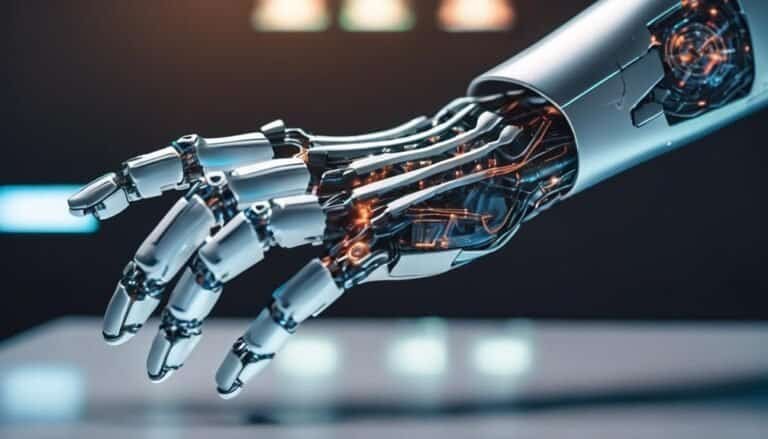AI and the Internet of Things (IoT): A Connected World
In the realm of technology, the convergence of Artificial Intelligence (AI) and the Internet of Things (IoT) is reshaping the way we interact with our surroundings. This amalgamation is not merely a trend but a transformative force that holds the potential to revolutionize various aspects of our lives.
The intricate interplay between AI and IoT devices is creating a web of interconnected systems that have implications across industries and sectors. As we witness the dawn of this connected world, the implications and opportunities that lie ahead are both intriguing and boundless.
Key Takeaways
- Industries benefit from the convergence of AI and IoT technologies for enhanced connectivity and data analysis.
- Smart environments and healthcare services are revolutionized through AI and IoT integration for efficiency and personalized care.
- Manufacturing embraces data-driven decision-making with AI and IoT, leading to optimized production and improved patient outcomes.
- Enhanced diagnostics, predictive maintenance, and opportunities in healthcare demonstrate the transformative power of AI and IoT integration.
The Rise of AI and IoT
The emergence of AI and IoT technologies has catalyzed a transformative shift in how industries operate and how everyday devices interact, marking a pivotal moment in the evolution of technological integration. AI advancements have enabled machines to simulate human intelligence processes such as learning, reasoning, and problem-solving. This has led to significant improvements in automation, predictive analytics, and decision-making processes across various sectors.
In parallel, IoT integration has facilitated the interconnectedness of devices, allowing them to collect and exchange data seamlessly. This interconnected network of devices, equipped with sensors and actuators, can communicate and collaborate in real-time, creating a web of physical objects that enhance efficiency and convenience. The fusion of AI and IoT has resulted in smart systems that can adapt and respond to changing environments autonomously.
Industries are leveraging AI algorithms to analyze the vast amounts of data generated by IoT devices, extracting valuable insights to optimize operations, enhance customer experiences, and drive innovation. As AI and IoT continue to evolve, their convergence is set to revolutionize industries, paving the way for a more connected and intelligent future.
Enhancing Connectivity Through Data
In the realm of AI and IoT, the fusion of data-driven connectivity solutions holds the key to optimizing network performance and enhancing overall system efficiency.
Streamlining IoT communication through advanced data analytics enables real-time decision-making and proactive maintenance strategies, fostering a seamless interconnected environment.
Data-Driven Connectivity Solutions
Harnessing the power of data analytics in connectivity solutions is revolutionizing the way AI and IoT devices interact and communicate in modern technology ecosystems. Data-driven connectivity solutions are at the forefront of innovation, enabling seamless integration and communication between devices.
Key aspects include:
- Real-time Data Processing: Enhancing connectivity through instant data analysis.
- Predictive Maintenance: Utilizing data analytics to foresee maintenance needs.
- Optimized Resource Allocation: Allocating resources efficiently based on data insights.
- Enhanced Security Measures: Implementing robust security protocols through data-driven strategies.
This integration of IoT integration and machine learning is reshaping connectivity paradigms, paving the way for smarter, more efficient systems in the interconnected world of AI and IoT.
Streamlining Iot Communication
Enhancing IoT communication efficiency through data-driven strategies is key to optimizing connectivity in modern technology ecosystems. Communication optimization techniques, such as data aggregation, play a vital role in streamlining IoT communication processes.
By aggregating data from multiple sources, IoT devices can transmit information more efficiently, reducing latency and improving overall network performance. This approach enhances connectivity efficiency by ensuring that relevant data is processed and transmitted in a timely manner. Moreover, it contributes to network scalability, allowing IoT systems to accommodate a growing number of connected devices without compromising performance.
Implementing data-driven strategies not only streamlines IoT communication but also paves the way for more robust and interconnected technology infrastructures.
Impact on Smart Environments
The impact of AI and IoT on smart environments encompasses the revolution in smart homes, advancements in energy efficiency, and the critical considerations of security and privacy.
These technologies are reshaping how individuals interact with their living spaces, enabling greater convenience, control, and sustainability.
As smart environments become more prevalent, the optimization of energy consumption and the safeguarding of personal data will continue to be at the forefront of discussions surrounding their adoption.
Smart Homes Revolution
The integration of AI with the Internet of Things is catalyzing a transformative evolution in the way smart homes interact within the broader spectrum of smart environments. This revolution is reshaping how we live, offering enhanced convenience, efficiency, and security. Key aspects driving this change include:
- Home Automation: Streamlining daily tasks and improving overall quality of life.
- Connected Devices: Enabling seamless communication and control between various appliances and systems.
- Personalization: Tailoring experiences to individual preferences through data-driven insights.
- Security Enhancements: Implementing robust measures to safeguard privacy and data integrity.
As smart homes become more prevalent, the impact on smart environments is profound, paving the way for a more interconnected and intelligent future.
Energy Efficiency Enhancements
Implementing advanced energy efficiency solutions within smart environments significantly optimizes resource utilization and operational sustainability. Smart grids play a crucial role in managing energy consumption by integrating renewable energy sources and enabling two-way communication between devices.
Energy management systems enhance efficiency by monitoring energy usage, analyzing patterns, and adjusting settings accordingly. These systems can automatically regulate heating, cooling, and lighting based on occupancy and environmental conditions, reducing energy waste.
By leveraging AI algorithms, smart environments can predict energy demands, optimize distribution, and minimize costs. This proactive approach not only reduces environmental impact but also lowers utility bills for consumers.
Security and Privacy
How do security and privacy considerations impact the functionality and integrity of smart environments?
In the realm of AI and IoT, ensuring robust security measures and data protection is crucial for maintaining trust and safeguarding sensitive information. Here are some key points to consider:
- Vulnerabilities: Smart devices can be vulnerable to cyber attacks, jeopardizing the entire ecosystem.
- Data Privacy: Unauthorized access to personal data can lead to privacy breaches and misuse.
- Compliance: Adhering to regulations such as GDPR is essential to avoid legal repercussions.
- Continuous Monitoring: Regular security assessments and updates are necessary to stay ahead of evolving threats.
Implementing stringent security protocols and prioritizing data protection are imperative for the sustainable growth of smart environments.
Advancements in Industrial Solutions
With the rapid integration of AI and IoT technologies, industrial solutions have undergone significant enhancements in efficiency and productivity. Industrial automation has been revolutionized through the implementation of AI algorithms that enable machines to operate more autonomously, optimizing processes and reducing human intervention. Smart factories, equipped with IoT sensors and AI analytics, can now predict maintenance needs, streamline production lines, and minimize downtime.
These advancements have led to a paradigm shift in the industrial landscape, where data-driven decision-making and real-time optimization are becoming the norm. By harnessing the power of AI to analyze vast amounts of data generated by IoT devices, manufacturers can identify patterns, detect anomalies, and continuously improve operations.
Moreover, the integration of AI and IoT technologies has facilitated the concept of predictive maintenance, where machines can self-monitor their performance and alert operators before breakdowns occur. This proactive approach not only reduces maintenance costs but also ensures uninterrupted production schedules in industrial settings. In conclusion, the synergy between AI and IoT is reshaping industrial solutions, paving the way for smarter, more efficient processes.
Revolutionizing Healthcare Services
The integration of AI and IoT technologies in the healthcare sector is revolutionizing the delivery of medical services, enhancing patient care through data-driven insights and predictive analytics. This transformation is evident in various aspects of healthcare services, with a particular focus on improved diagnostics and remote monitoring.
- Enhanced Diagnostics: AI algorithms are being utilized to analyze medical imaging scans and diagnostic tests, leading to more accurate and timely diagnoses.
- Remote Monitoring: IoT devices enable continuous monitoring of patients' vital signs and health metrics in real-time, allowing for early detection of health issues and proactive interventions.
- Predictive Analytics: By leveraging AI-powered predictive analytics, healthcare providers can anticipate disease progression and tailor personalized treatment plans for better patient outcomes.
- Improved Patient Care: The seamless integration of AI and IoT technologies streamlines healthcare processes, reduces errors, and enhances overall patient care experience.
These advancements signify a paradigm shift towards more efficient, precise, and patient-centric healthcare services.
Future Implications and Opportunities
Exploring the future implications and opportunities arising from the integration of AI and IoT in healthcare unveils a landscape rich with potential advancements and transformative possibilities. The synergy between AI and IoT presents a plethora of opportunities for enhancing patient care, optimizing operational efficiencies, and driving innovation in the healthcare industry. However, along with these opportunities come significant challenges that need to be addressed to fully realize the potential benefits of this integration.
| Opportunities | Challenges | Implications |
|---|---|---|
| Personalized Medicine | Data Security Risks | Improved Patient Outcomes |
| Remote Patient Monitoring | Interoperability Issues | Enhanced Operational Efficiency |
| Predictive Analytics | Ethical and Legal Concerns | Accelerated Medical Research |
| Smart Healthcare Systems | Integration Complexity | Cost Savings and Resource Allocation Efficiency |
These opportunities pave the way for a future where healthcare delivery is more personalized, efficient, and effective. Overcoming the challenges will require collaboration between technology experts, policymakers, and healthcare professionals to ensure the responsible and effective implementation of AI and IoT in healthcare systems. By navigating these challenges successfully, the healthcare industry stands to benefit immensely from the transformative power of AI and IoT integration.
Conclusion
In conclusion, the integration of AI and IoT has ushered in a new era of connectivity and efficiency across various industries.
The synergy between these technologies has paved the way for smarter environments, enhanced industrial solutions, and improved healthcare services.
As we look towards the future, the opportunities and implications of this connected world are vast and promising.
The fusion of AI and IoT continues to shape our world in ways that were previously unimaginable.







